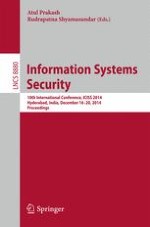2014 | Book
Information Systems Security
10th International Conference, ICISS 2014, Hyderabad, India, December 16-20, 2014, Proceedings
Editors: Atul Prakash, Rudrapatna Shyamasundar
Publisher: Springer International Publishing
Book Series : Lecture Notes in Computer Science
